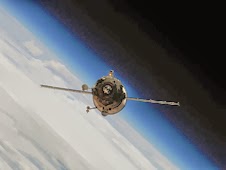Astronauts work to install the new coolant pump. Credit: NASA TV.
On a Christmas Eve EVA, astronauts Rick Mastracchio and Mike Hopkins completed repairs to the station's cooling system by finishing installation of the new Pump on the station truss segment. During the spacewalk, designated EVA-25 by NASA, the pair of explorers managed to complete in two spacewalks all the tasks that had been planned for three! The original plan called for the first EVA to disconnect the broken equipment, then on the second EVA the pump would be removed and stored safely while the new system would be placed, and finally on the third EVA the installation of the new unit would be completed. Instead, the astronauts showed their professionalism and skill by fitting all three EVA tasks into two long EVA's. This second spacewalk lasted
Astronaut Maastrachio works on the pump.
According to NASASpaceFlight.com, new quick-disconnect pipes on the coolant pump helped to make removal of the device much more simple than previous designs would have allowed. On the first spacewalk Saturday, the astronauts got ahead of schedule and finished the removal of the bad unit and connected the hoses back into the system so that the coolant could remain liquid inside the station. Then on Tuesday the astronauts removed the protective insulation around the new unit, which had been thoughtfully placed on a storage position on the truss ahead of time, and then moved the pump into position for final installation.
Mike Hopkins, space repairman.
After the first spacewalk, it was thought that water had again gotten inside one of the suits, but it turned out that the water had leaked during procedures once the men were back inside the station. Rick Mastracchio was actually glad to have ended EVA-24 a bit early, as there were some discomfort issues with his spacesuit near the end of the spacewalk. He used a different suit for the EVA-25.
Check out the detailed description of the spacewalk at NASASpaceflight.com:
The fun does not stop! Even now as I write this, the Russians are performing another spacewalk. Commander Oleg Kotov and Flight Engineer Sergey Ryazanskiy are outside the station installing scientific experiments and two special Canadian cameras which recently arrived on a Progress cargo spacecraft. Kotov also has a GoPro camera on his spacesuit arm, so we would hope to see some interesting views eventually.














